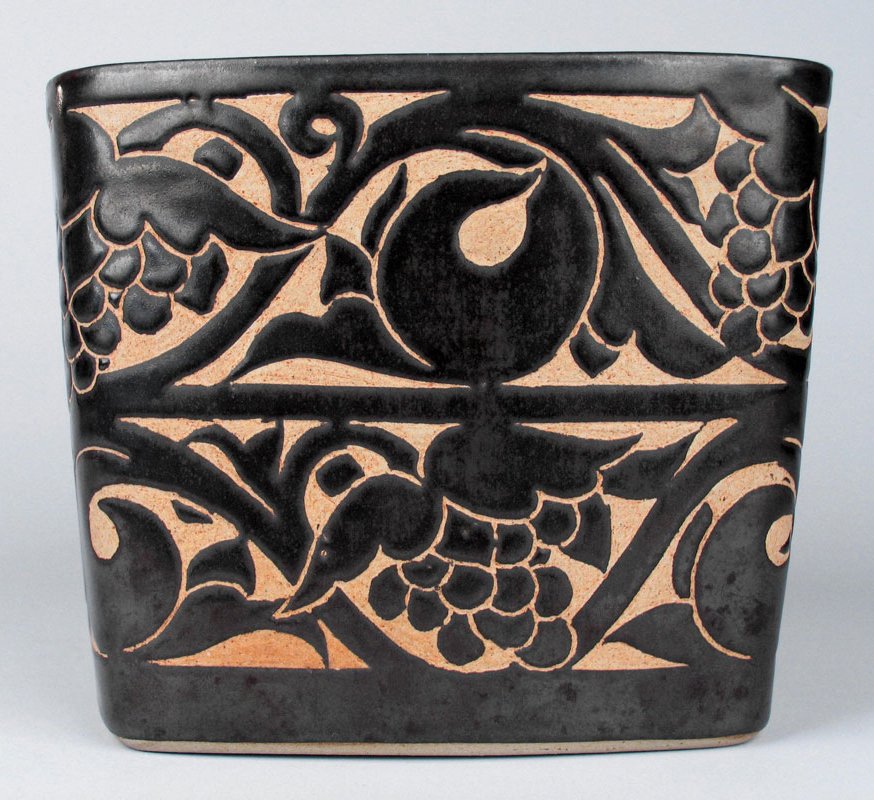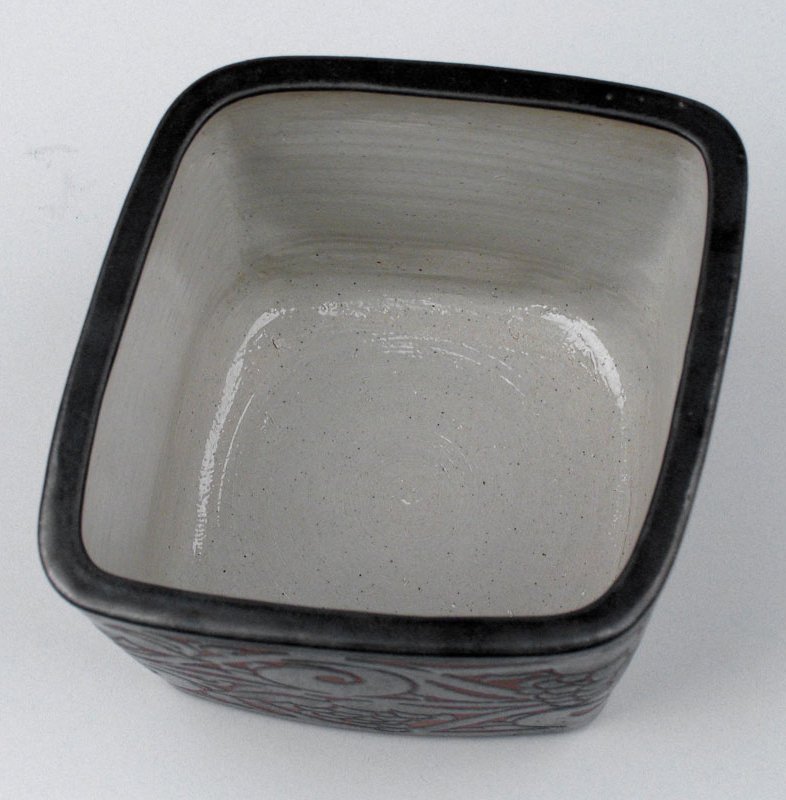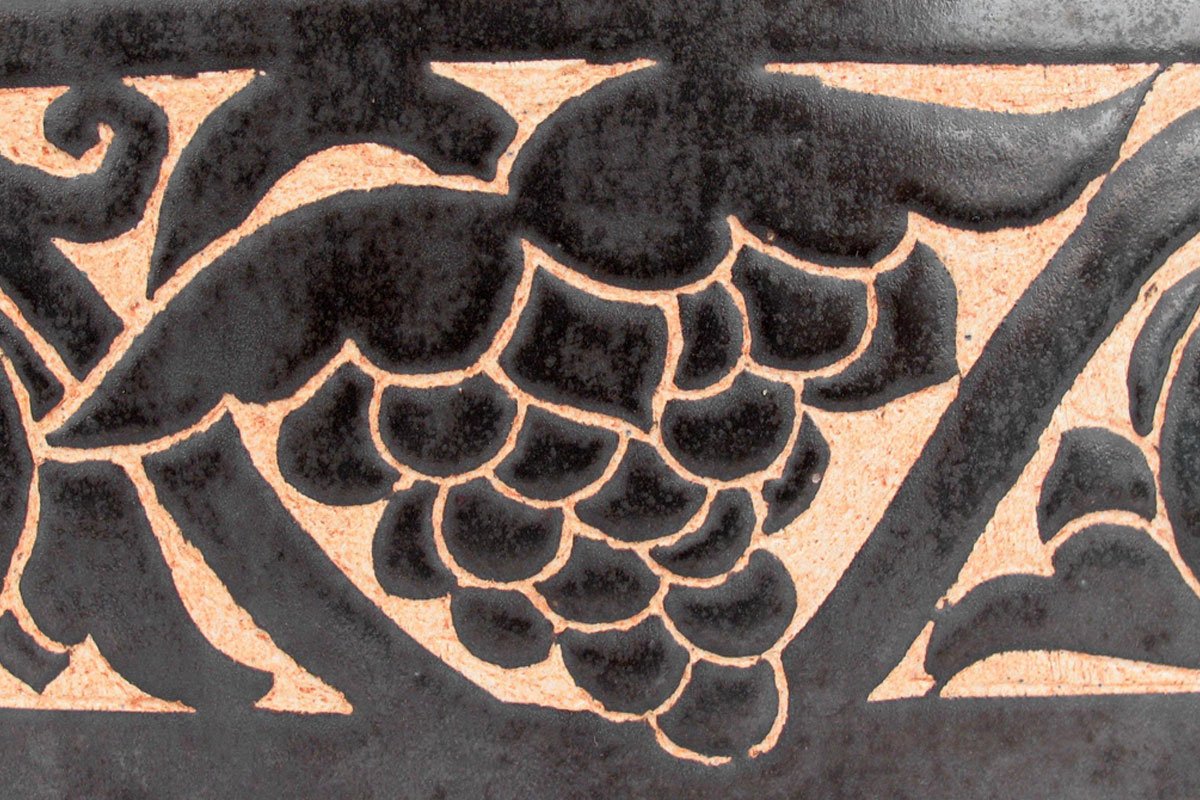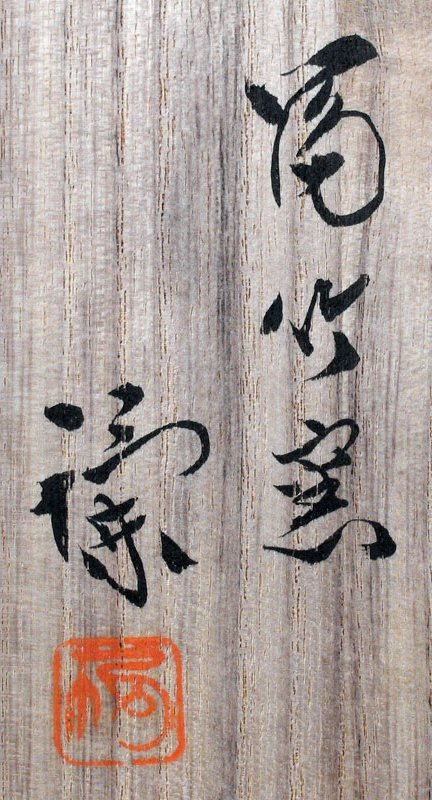POST WAR & CONTEMPORARY
MIYANOHARA KEN, 1965 EXHIBITION, PORCELAIN MIZUSASHI WITH GRAPE VINES
Mizusashi or water container for matcha tea ceremony in a diamond form ornamented on the sides with bands of scrolling grape vines. Of hand-molded porcelain with a thick, iron-oxide black glaze, carved away to the bisque surface to realize the design. Signed on the reverse with an impressed, seal-form signature by the artist: Ken (Miyanohara Ken, 1898 – 1977). Showa 40 or 1965.
With a niju-bako or double storage box, the exterior box lacquered red and the interior, paulownia wood box inscribed on the exterior of the lid: Koku Yu Budo Mon Mizusashi or Carved Glaze Grape Design Water Jar; and on the reverse of the lid inscribed: Fuchiku-Gama or Fuchiku Kiln, and signed: Ken and sealed.
This mizusashi was made for exhibition at the 15th Goto Ten (Exhibition of Modern Japanese Paintings and Sculptures) in 1965, and it is illustrated in the catalogue of the exhibition, number 175.
It is now in the collection of the Philadelphia Museum of Art.
Born in Kagoshima City, Miyanohara Ken first wanted to become an architect, studying that profession at Waseda University beginning in 1916. After falling ill, he left school. Subsequently his life took a new direction. After briefly exploring Nihonga painting under Yamanouchi Tamon (1878 – 1932) and Western style painting at the Kawabata Ga Gakko (Kawabata Painting School), he started studying ceramics in 1923 under Miyagawa Kozan II and Itaya Hazan. In 1925, he built his first kiln in the garden of his home in Tokyo, and the next year after moving to Tozuka in Kanagawa Prefecture, he built a second one. In 1927, he participated in the formation of the art association Totokai (Eastern Ceramic Association), which was led by Itaya Hazan, Numata Ichiga, and Miyagawa Kozan II. The following year, he entered a flower container with an orchid motif into the 15th Shokosho Kogei Ten (Ministry of Commerce and Industry Craft Exhibition). In 1929, he showed with the 1st Annual Totokai Exhibition, held at the Nihonbashi branch of the Mitsukoshi Department Store (a venue he continued to participate in every year thereafter until 1940). Also in 1929, he exhibited at the 10th Teiten, winning an award for the first time. He continued to exhibit at the government-sponsored exhibitions with the 11th – 15th Teiten in 1930 – 1934, the Kaiso Dai Ikkai Teiten and the Bunten Kansaten in 1936, the 1st – 3rd Shin-Bunten in 1937 – 1939, the Hoshukuten in 1940, the 5th and 6th Shin-Bunten in 1942 – 1943, and the Senji Tokubetsu Ten in 1944. His home and kiln in the Kamada district of Tokyo were destroyed in the aerial bombing of 1945, and he fled the city for Tsukuba, where he built a kiln from a patchwork of strewn bricks in 1946. In February of 1948, he moved to Matsudo City in Chiba Prefecture outside of Tokyo, where he rebuilt his kiln and continued to work for the next 30 years. After the Pacific War, he returned to the government-sponsored exhibitions with the 1st Nitten in 1946 as well as the 5th – 13th in 1949 – 1957.
Miyanohara pioneered new, distinctive techniques for ornamenting ceramics: building up glaze on the surface, inlaying of one glaze into another, sculpting an applied glaze away from the body to reveal a design, using tenmoku with cinnabar glaze, and employing a “gold thread” streaked glaze.
For other examples of his work, c.f. Selected Masterpieces from the University Art Museum, Tokyo National University of Fine Arts and Music: Grand Opening Exhibition, page 263, number 115, and the Chiba Prefectural Museum of Modern Art retrospective catalogue Kindai Togei no Seika: Miyanohara Ken (An Unparalleled Artist in the Field of Modern Ceramics: Miyanohara Ken).
Miyanohara Ken, 1965 Exhibition, Porcelain Mizusashi with Grape Vines
Artist Name: Miyanohara Ken
Period: Showa Post War
Mediums: Porcelain
Form: Mizusashi
Origin Country: Japan
6 7/8” high x 9 3/8” wide x 8 ¼” deep
This piece is no longer available.




